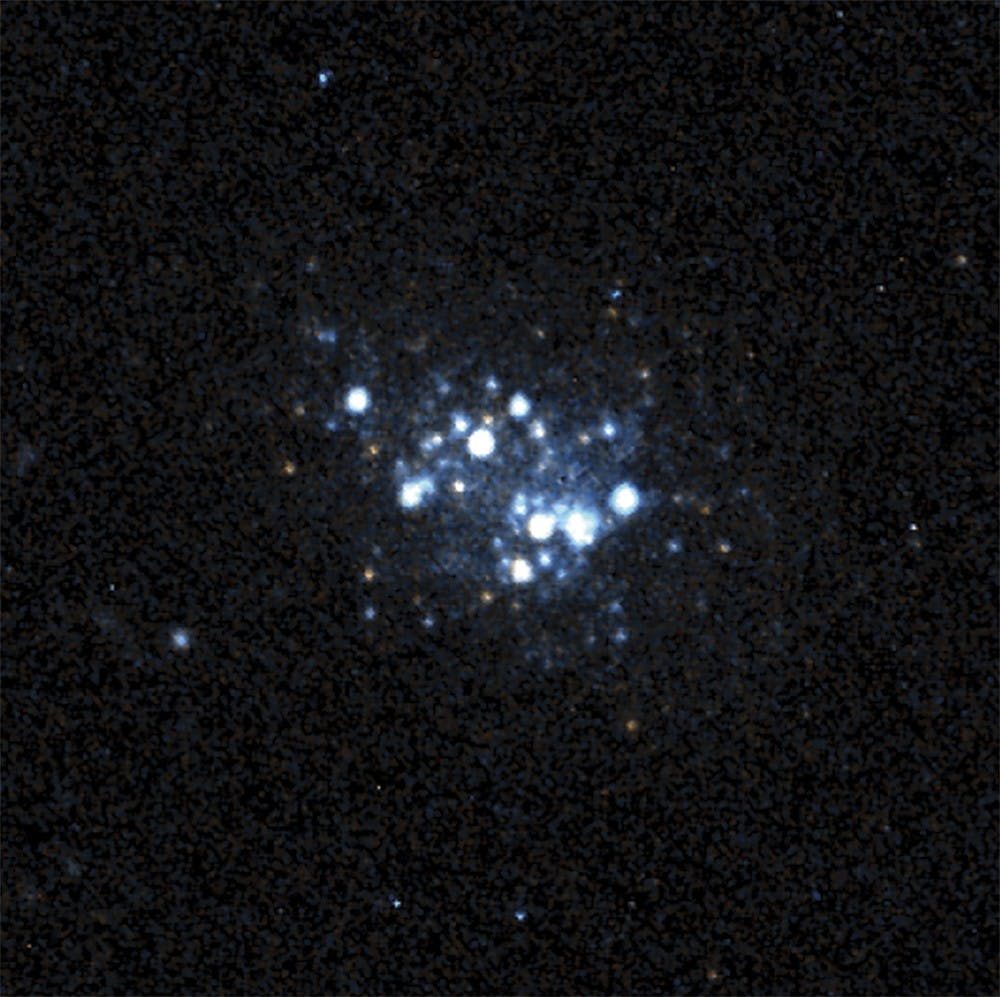It was a routine four nights at Kitt Peak National Observatory for graduate student Alec Hirschauer. His third trip to the Arizona mountaintop, this was a chance to build his dissertation with data virtually pulled from the cosmos.
But the spectra Hirschauer, a Ph.D candidate in astronomy at IU, collected last April for “Leoncino,” or Galaxy AGC 198691 — a faint blue dwarf system around 30 million light-years from Earth — were anything but ordinary.
Once published, Hirschauer’s findings would catapult Leoncino to international recognition among astronomers as the most metal-poor galaxy ever recorded. His study, released this month in the Astrophysical Journal and co-authored by IU astronomers Katherine Rhode and John Salzer, has not only shed light upon the mysterious chemical makeup of AGC 198691, but it has laid the very groundwork for future studies that will likely propel scientists toward a direct test of the current Big Bang model.
Astronomers use the terms “metal-poor” and “metal-rich” to refer to the number of elements churned out by stars throughout billions of years.
Stellar composition is far more primitive in metal-poor galaxies. Earth’s galaxy, the Milky Way, falls on the opposite spectrum as a fairly metal-rich system. This is because of a long history of “stellar processing,” or the cycle in which a star ejects heavier elements into its surroundings as it ages.
“Basically, the measure of heavy element abundance in a given system is going to be a representation of how many successive generations of star formation have taken place,” Hirschauer said.
On his fourth night of observation at Kitt Peak, temperatures hovered near the freezing point. This was typical for April on the mountain, where 26 domed telescopes form a small village high above the Sonoran desert. One of these domes houses the WIYN 3.5-meter telescope, a research hotspot for IU astronomers.
However, Hirshauer had elected to use the observatory’s 4-meter telescope because of its powerful spectrograph. Having gathered all necessary data from the spectrograph, Hirshauer was ready to return to Bloomington.
“After spending four nights on a mountaintop, basically alone, on a daytime sleep schedule, you just want to go home,” he said.
Then came a slight twist in plot. The astronomer, encouraged by his advisor, Salzer, decided to observe a handful of neutral-gas dwarf galaxies that a collaborator had recommended. Leoncino was on the lineup that last night.
Back in Bloomington, long hours of image processing, careful line measurements and feeding numbers through a throng of software awaited.
Then Hirschauer ran into an abnormality.
“It’s a very laborious process,” he said. “But the end result is you get this number that represents the overall oxygen abundance of your specific galaxy. Something that’s extremely metal-deficient is below 7.65 on the scale we use. I got one with a value of 7.00.”
It was Leoncino.
Right away, Hirschauer approached the number with skepticism.
“I was like, ‘I don’t know about this. I don’t know if I believe that.’ So I brought it to my adviser’s office and I sat down ... We pulled up the data, brought it up on screen, and John was like, ‘This actually could be interesting.’”
Salzer had a similar recollection of the oxygen abundance.
“I was also not ready to believe him,” he said. “This wasn’t the first time a student had made this type of claim and turned out to be wrong.”
However, after measuring the spectrum himself Selzer said he was convinced they had a winner.
The next few months were a matter of waiting for verification.
A team of astronomers from University of Minnesota offered to observe Leoncino for two nights on the MMT, a robust 6.5-meter telescope in Arizona, but the star cluster wouldn’t be visible until five months later — November of 2015. Come November, Hirschauer set about analyzing this second set of data. He got the same number back: 7.00.
"That's when we decided 'hey, we gotta put this thing into print", Hirschauer said.
Leoncino was originally discovered by a team of Cornell University researchers seeking galaxies rich in neutral hydrogen gas. Leoncino, fitting this criteria, blipped on their radar in 2005.
Now with Hirschauer’s study, Leoncino has been established as a “time capsule” of what star formation systems looked like shortly after the Big Bang — and thanks to its relative proximity to the Milky Way, we can study it in fairly good detail.
This find, along with the route Cornell University astronomers used to identify Leoncino, effectively set up a tried-and-tested method to identify other “time capsules” around us.
As for future plans, Salzer and Hirschauer have a fairly good idea of this study’s implications.
“There are numerous other studies that I can imagine happening in the next few years, Salzer said.



